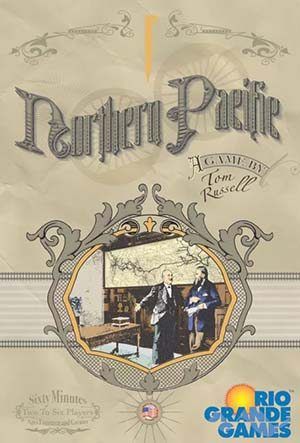Northern Pacific Board Game Review

By MARK WILSON

Year Published: 2013
Players: 3-6
Playing Time: 60 Minutes
The cube rails genre sits askew from mainstream trends, but it also subverts expectations of what gamers usually expect when they get the elevator pitch.
The shortest pitch might be “train games, but not nearly as complicated as you’re imagining when I say that.”
A longer list of characteristics might include the following:
- Streamlined rule sets. Rulebooks that are generally 2-4 pages long.
- Route-building on a shared, central space. It might be points along lines, it might be a hex map, but the general mechanic holds true.
- Often, stock holding. Occasionally, stock exchanges. More usually, there’s some auction structure involved.
- Shared incentives; meaning that you will rarely take actions that help you alone, and so the strategy involves setting yourself up for numerous mutually beneficial pseudo-partnerships, even though you’re all competing.
- Often lots of money transactions.
- Trains.
Northern Pacific jettisons even some of these, distilling the genre down to its rawest elements. It’s the least “cube rails-y” game in the genre. But it’s also the MOST of certain aspects.
I’ll explain.
Cube or Train?
The game’s marketing lingo promises this central question as the only asked of players. And, holy hell, it’s right!
But it’s also burying the lead, that of the implications behind each of your decisions.
On your turn, you’ll place one of your cubes on a city on the map, or place a train to move the train from one city to another. There are a few minor rules about placement of both, but the goal is to get the train to visit your cubes, which come back to you with interest. If the train passes your city by, it remains there, unloved and mechanically useless, to act as a negative tiebreaker at game’s end.
Cubes returned – plus those gained via train stops – are your points for the round. The game is generally played over three such rounds.
And that’s it. Minus a couple small rules, I just taught you the game.
When Simplicity Works
No stocks, minor route-building…so how does Northern Pacific separate itself?
Shared incentives. See, you’ll be occupying cities with other players, but with cube limits on cities, never ALL players. And since you can only make one move on your turn, you’re at the mercy of other players oftentimes in regard to whether or not your cities will be visited.
So the game quickly expands into this space, both with napkin math being done to hedge your bets in regard to placements and table talk to form temporary alliances.
The most dangerous thing is the player without an incentive to head in a particular direction. Or perhaps they do, but they realize that nothing in that direction helps them more than anyone else. And so they’ll tank their score simply to tank others’ harder.
This is not a cruelty. This is a lack of foresight by the other players. You can’t be greedy in this game, not exclusively, because you’ll lose without incentivizing others to come along for the ride.
Negotiation Space in Games
This is not a Negotiation Game in a descriptive sense. It’s probably not listed as such on the game’s Board Game Geek page or marketing copy. But in any practical sense, that is often how I’d refer to it above anything else.
Player count matters here. At six players, my least favorite player count, you’re often just reacting to the board state on your turn. You can never accurately predict the next five moves, so the strategy is very approximate. Table talk is still possible, but is more nebulous, because it’s harder to make promises that you can keep in regard to another’s chances.
At 3-4P, however, it’s basically a negotiation game, particularly because the game plays out over multiple rounds. By the final round, you’re not just surveying the board to figure out how best to help yourself. You’re doing it in a way that will bridge the gap between you and the leader.
To do that, you may find yourself open collaborating with other players, trying to convince them into schemes, or being pitched on their ideas.
Or, if you’re the leader, the trick is how to make it impossible for others NOT to help you enough to win.
If it sounds like there’s a potential kingmaking problem embedded here, you’re right. Except it’s not a problem. It’s an explicit feature of the game, and better off for it. If you dislike helping others as much as yourself at times, and potentially playing kingmaker in the game’s final few turns, this isn’t the game for you. But I refuse to call such elements problems when they create such delicious situations to explore, situations that couldn’t exist without the possibility of kingmaking.
Depth From Simplicity
There’s nothing wrong with adding mechanical layers to games, but all else being equal, give me a game that does more with less.
Northern Pacific is sanded down even within its somewhat austere genre. I hate to call games with rich interpersonal spaces “minimal,” because they aren’t. But the rules get out of the way almost immediately here, and that direct interaction becomes the entire game.
I love player-driven games, and this one is no exception. I would pump the brakes slightly in saying it’s one I’d want to play all the time. It’s a good thing, but it’s a lot of the same thing over and over. One of my few wishes for the game is that it had different official maps, simply to shake up the spatial puzzle that accompanies the human puzzle of it all.
But not all games need to be played 10-100 times per year. I pull this 3-5 times and love it each time, and that’s plenty. Despite this potentially being my favorite cube rails game, I own two others (Iberian Gauge, also from designer Amabel Holland, and American Rails), because they serve different functions in my collection.
The minimalism in presentation and rules makes these games a tough sell for many. There’s nothing flashy. But under the surface, there are depths untold, without having to internalize complex rule sets that provide another barrier to entry. I appreciate them for this, and appreciate Northern Pacific for being such a sneakily cutthroat psychological experiment, even as it hides in the guise of just another train game.
…
For more content, or just to chat, find me on Twitter @BTDungeons, and if you enjoy my work, be sure to subscribe on Youtube!
Share
Recent Posts
Categories
- All (350)
- Announcements (4)
- Board Games (203)
- DMing (28)
- Game Design (16)
- Playing TTRPGs (22)
- Reviews (189)
- RPGs (142)
- Session Reports (91)
- Why Games Matter (9)